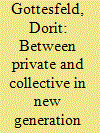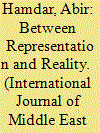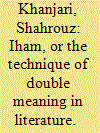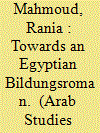| Srl | Item |
| 1 |
ID:
158075


|
|
|
|
|
| Summary/Abstract |
The article examines new generation Palestinian writing in the West Bank, focusing on the ongoing tension between the private and the collective dimensions in literary works there. The works of Palestinian writer of Ramallah, Akram Musallam (b. 1971), serve as test case. The article shows that Musallam's novels preserve a connection to the Palestinian problem and the national-political life on one hand, and create meanings beyond time and place limited by this connection, on the other. The tension between the private and the collective is not only well reflected in Musallam's writings, but in fact constitutes their main pivot and it is embodied in an original and unique inner thematic and stylistic struggle within his writings. Musallam's works serve as an example of the fact that despite recent trends to forsake the collective and focus on the private, Palestinian literature almost always relates, either directly or indirectly, either through creative or less creative means, to collective Palestinian issues.
|
|
|
|
|
|
|
|
|
|
|
|
|
|
|
|
| 2 |
ID:
164756


|
|
|
| 3 |
ID:
192994


|
|
|
|
|
| Summary/Abstract |
This article examines the chapter on īhām (literary amphiboly) in Ḥadāʾiq al-Siḥr by Rashīd Vaṭvāṭ (d. 1182). Ḥadāʾiq, a treatise on stylistics with Persian and Arabic examples, is the oldest extant document to define īhām. Vaṭvāṭ's definition of īhām sheds light on the mechanism and function of this literary technique. This article argues that īhām, according to Vaṭvāṭ, operates through the creation of semantic fields and defamiliarization. Previous scholars who examined this chapter of Ḥadāʾiq, oblivious to this point, have made a number of misinterpretations. However, by analyzing the name he prefers for this figure of speech, the definition he gives, and the examples he cites to explain it, this article demonstrates that Vaṭvāṭ had this function of defamiliarization in mind.
|
|
|
|
|
|
|
|
|
|
|
|
|
|
|
|
| 4 |
ID:
170484


|
|
|
|
|
| Summary/Abstract |
Reading Naguib Mahfouz's Sugar Street (1957) as a Bildungsroman, I argue that Mahfouz creates an Egyptian Bildungsroman that relies on constant revision of European forms and a merging of local and global paradigms to fit the Egyptian socio-historical context. Mahfouz rejects both the traditional Bildungsroman as well as classical indigenous forms as signifiers of mimicry and petrification respectively. While the resolution of the Bildungsroman entails the negation of the Other, whose maturation is requisite upon accepting models that marginalize him/her, classical models render the Other a geographic and temporal anachronism. In place of the traditional Bildungsroman and classical Arabic literary models, Mahfouz advocates for an eclectic paradigm that changes with the historical moment.
|
|
|
|
|
|
|
|
|
|
|
|
|
|
|
|